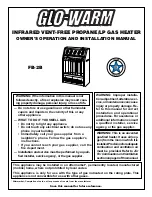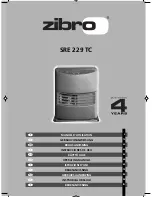
4
Installation Instructions and Owner’s Manual
Unvented LP-Gas Vent Free Room Heaters
Product Features
Figure 1
SAFETY DEVICE
This heater has a pilot with an Oxygen Depletion Sen
-
sor (ODS) safety shut off system. The ODS/pilot shuts
off the heater if there is not enough fresh air.
IGNITION SYSTEM / BATTERY INSTALLATION
– The heater is equipped with an electronic manual
ignitor. This system requires no matches, or other
source to light heater, but does require one AA battery
to operate ignitor.
(AA Battery included)
.
To install or replace battery unscrew the ignitor cap
(red button), insert battery positive (+) terminal up
and replace cap.
(AA Battery included)
THERMOSTATIC CONTROL
These heaters have a control valve with a thermostat
sensing bulb. This results in the greatest heater comfort
and may result in lower bills.
BLOWER FAN CONTROL SWITCH OPERATION
These heaters also include an electrical blower. The
blower switch has three positions: MANUAL, OFF and
AUTO. In AUTO, the blower will turn on and off as the
heater cycles on and off. On MANUAL, the blower will run
continuously. To turn blower off, use the OFF position.
LOCAL CODES
Install and use heater with care.
Installation must conform to local codes or in the
absences of local codes, use the latest edition of
National Fuel Gas Code ANSI Z223.1/NFPA 54.
UNPACKING
1. Remove heater from carton.
2. Remove all protective packaging applied to
heater for shipment.
3. Check heater for any shipping damage. If
heater is damaged, promptly inform dealer
where you bought heater.
FRESH AIR FOR COMBUSTION AND
VENTILATION
WARNING
: This heater shall not be installed in
a confined space or unusually tight construction
unless provisions are provided for adequate
combustion and ventilation air. Read the following
instructions to insure proper fresh air for this and
other fuel-burning appliances in your home.
ESTABLISHING ADEQUATE VENTILATION
The following are excerpts from
National Fuel Gas
Code, NFPA 54/ ANSI Z223.1, Section 5.3, Air for Com-
bustion and Ventilation
. All spaces in homes fall into
one of the three following ventilation classifications:
1. Unusually Tight Construction
2. Unconfined Space
3. Confined Space
This heater must not be installed in a confined space
or unusually tight construction unless provisions are
provided for adequate combustion and ventilation air.
The information on pages 4 through 6 will help you
classify your space and provide adequate ventilation.
Unusually Tight Construction
If your home meets all of the three following criteria you
must provide additional fresh air. See
Ventilation Air
from Outdoors
, page 6.
Unusually tight construction is defined as construction
where:
a. Walls and ceilings exposed to the outside atmo
-
sphere have a continuous water vapor retarder with
a rating of one perm (6 x 10
-11
kg per pa-sec-m
2
) or
less with openings gasketed or sealed and
b. Weather stripping has been added on openable
windows and doors, and
c. Caulking or sealants are applied to areas such
as joints around windows and door frames,
between wall-ceiling joints, between wall panels, at
penetrations for plumbing, electrical, and gas lines,
and at other openings.
If your home does not meet all of the three criteria
above, see
Deterzmine the Type of Heater Location
Space
, page 5.
Confined Space and Unconfined Space
The
National Fuel Gas Code, NFPA 54/ ANSI Z223.1
defines a confined space as a space whose volume is
less than 50 cubic feet per 1,000 Btu per hour (4.8 m
3
per kW) of the aggregate input rating of all appliances
installed in that space, and an unconfined space as a
space whose volume is not less than 50 cubic feet per
1,000 Btu per hour (4.8 m
3
per kW) of the aggregate
input rating of all appliances installed in that space.
Rooms communicating directly with the space in which
the appliances are installed*, through openings not fur
-
nished with doors, are considered a part of the uncon
-
fined space.
Ignitor Button
Control Knob
Grill
Front Panel
Burners
Heater
Cabinet
Fan Blower
Switch
(located on back
of heater)





































